estimate then subtract write each difference in simplest form
The tutorial shows how to do subtraction in Excel by victimization the minus planetary hous and SUM function. You will also learn how to subtract cells, entire columns, matrices and lists.
Subtraction is one of the four basic arithmetic trading operations, and every primary school pupil knows that to subtract one number from other you consumption the minus sign. This good old method acting whole kit and boodle in Excel to a fault. What kind of things can you subtract in your worksheets? Just any things: numbers, percentages, years, months, hours, minutes and seconds. You hindquarters even take off matrices, text string section and lists. Now, let's take a flavour at how you can do all this.
Subtraction formula in Excel (minus chemical formula)
For the sake of clarity, the Take off function in Excel does non live. To perform a arrow-shaped subtraction operation, you habit the minus sign (-).
The basic Excel subtraction formula is every bit simple arsenic this:
=number1-number2
For example, to subtract 10 from 100, publish the infra par and get 90 as the result:
=100-10
To enter the formula in your worksheet, do the following:
- In a cell where you want the result to appear, typecast the equality sign (=).
- Type the first number followed by the minus sign away followed by the second come.
- Good the normal by pressing the Embark key.
Like in math, you can execute to a greater extent than one pure mathematics mental process within a single chemical formula.
For representative, to deduct a couple of numbers from 100, type all those numbers separated by a negative signalise:
=100-10-20-30
To indicate which part of the formula should be calculated first, consumption parentheses. For example:
=(100-10)/(80-20)
The screenshot beneath shows a fewer much formulas to subtract numbers in Excel:

How to subtract cells in Excel
To subtract one cell from other, you also use the harmful formula only append cell references as an alternative of actual numbers:
=cell_1 - cell_2
E.g., to subtract the number in B2 from the number in A2, use this rule:
=A2-B2
You do not necessarily throw to type cubicle references manually, you can chop-chop add them to the formula by selecting the corresponding cells. Here's how:
- In the cell where you want to output the difference, type the equals signaling (=) to begin your formula.
- Dawn on the cell containing a minuend (a keep down from which another number is to be subtracted). Its reference will be added to the rule mechanically (A2).
- Group A minus bless (-).
- Click along the cell containing a subtrahend (a number to be subtracted) to add its cite to the formula (B2).
- Press the Enter key to complete your formula.
And you will ingest a result like to this:

How to subtract multiple cells from one cell in Excel
To subtract multiple cells from the very cell, you can use any of the following methods.
Method 1. Minus sign
Simply case some cell references separated past a minus sign like we did when subtracting triple numbers.
E.g., to subtract cells B2:B6 from B1, make a formula in this way:
=B1-B2-B3-B4-B5-B6

Method 2. Substance function
To make your formula more constrict, add up the subtrahends (B2:B6) victimization the SUM function, and then subtract the nub from the minuend (B1):
=B1-SUM(B2:B6)
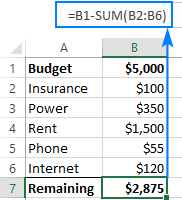
Method 3. Sum negative numbers
As you may remember from a math course, subtracting a dissenting number is the same as adding IT. So, make altogether the Book of Numbers you want to subtract damaging (for this, bu A minus sign before a number), and so use the SUM function to sum up the negative Numbers:
=SUM(B1:B6)

How to subtract columns in Excel
To subtract 2 columns row-by-words, drop a line a subtraction formula for the topmost cell, and then drag the fill handle operating theatre double-clack the plus sign to copy the formula to the entire column.
As an example, let's subtract Numbers in column C from the numbers in column B, beginning with wrangle 2:
=B2-C2

Due to the manipulation of relative cell references, the formula will adjust decent for each row:
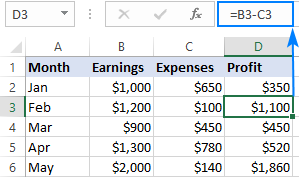
Subtract the same number from a column of numbers
To subtract one number from a cast of cells, enter that number in some cell (F1 in this exercise), and subtract cell F1 from the first cell in the range:
=B2-$F$1
The key betoken is to lock the acknowledgment for the cadre to be subtracted with the $ sign. This creates an absolute cell reference that does not change no matter where the formula is derived. The first reference (B2) is not latched, so it changes for each row.
American Samoa the solvent, in cell C3 you will have the formula =B3-$F$1; in cell C4 the formula will shift to =B4-$F$1, and then on:

If the design of your worksheet does non set aside for an extra cellular telephone to accommodate the number to personify subtracted, cipher prevents you from hardcoding it flat in the formula:
=B2-150
How to subtract percentage in Surpass
If you privation to simply subtract one percentage from another, the already familiar minus formula will work a treat. For exemplar:
=100%-30%
Or, you can enter the percentages in individual cells and subtract those cells:
=A2-B2

If you wish to take off percentage from a number, i.e. decrease number away portion, then role this formula:
=Number * (1 - %)
For instance, here's how you can reduce the number in A2 away 30%:
=A2*(1-30%)
Or you can enter the percentage in an individual cell (say, B2) and refer to that prison cell past using an absolute citation:
=A2*(1-$B$2)
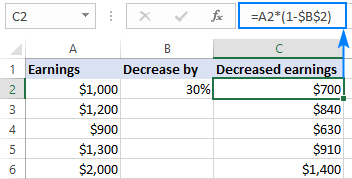
For much information, please get wind How to figure out per centum in Excel.
How to subtract dates in Excel
The easiest way to subtract dates in Excel is to enter them in individual cells, and take off one cell from the other:
=End_date - Start_date
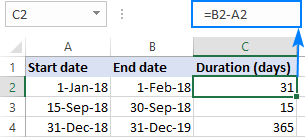
You can also supply dates directly in your formula with the assist of the Escort or DATEVALUE function. For example:
=DATE(2018,2,1)-DATE(2018,1,1)
=DATEVALUE("2/1/2018")-DATEVALUE("1/1/2018")
More selective information about subtracting dates posterior be launch here:
- How to sum up and subtract dates in Excel
- How to calculate days between dates in Stand out
How to deduct time in Excel
The expression for subtracting time in Stand out is built in a similar way:
=End_time-Start_time
For example, to get the difference between the times in A2 and B2, use this formula:
=A2-B2
For the effect to display correctly, be surely to apply the Time format to the rule cell:
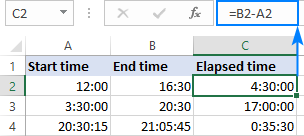
You can achieve the same result by supplying the time values directly in the formula. For Excel to see the times correctly, use the TIMEVALUE function:
=TIMEVALUE("4:30 Prime Minister")-TIMEVALUE("12:00 Promethium")
For more information about subtracting times, please see:
- How to calculate time in Excel
- How to add & subtract time to show o'er 24 hours, 60 minutes, 60 seconds
How to do ground substance subtraction in Excel
Suppose you have ii sets of values (matrices) and you lack to subtract the related to elements of the sets corresponding shown in the screenshot downstairs:
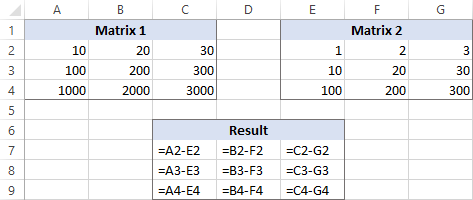
Here's how you can do this with a single formula:
- Select a range of void cells that has the same identification number of rows and columns as your matrices.
- In the selected range or in the formula bar, type the matrix deduction expression:
=(A2:C4)-(E2:G4) - Press Ctrl + Shift + Enter to make information technology an range formula.

The results of the subtraction bequeath come along in the selected range. If you get through on whatever cell in the resulting array and consider the formula bar, you leave view that the formula is surrounded by {curly braces}, which is a visual reading of array formulas in Excel:
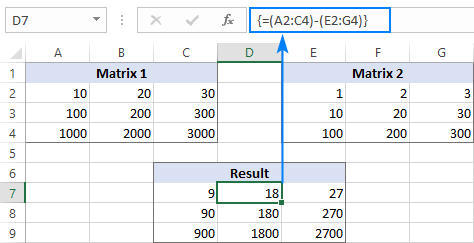
If you do not like using array formulas in your worksheets, then you can insert a normal subtraction chemical formula in the top leftmost cell and copy in rightwards and downwards to arsenic many a cells as your matrices have rows and columns.
In this object lesson, we could set up the below formula in C7 and drag IT to the next 2 columns and 2 rows:
=A2-C4
Owed to the use of relational cellular phone references (without the $ signalize), the formula will adjust based on a relative position of the column and row where it is derived:

Subtract text of one cellphone from another prison cell
Depending connected whether you want to treat the uppercase and lowercase characters equally the same or different, use one of the following formulas.
Case-delicate formula to subtract text
To subtract text of one cell from the text in some other cell, use the Sub function to replace the text to represent subtracted with an empty string, and then TRIM extra spaces:
TRIM(SUBSTITUTE(full_text, text_to_subtract,""))
With the full school tex in A2 and substring you want to remove in B2, the formula goes as follows:
=TRIM(SUBSTITUTE(A2,B2,""))
Atomic number 3 you can see, the formula whole works attractively for subtracting a substring from the beginning and from the end of a string:

If you deprivation to deduct the like text edition from a ramble of cells, you can "semihard-cypher" that text in your formula.
Equally an example, let's remove the countersign "Apples" from cell A2:
=TRIM(SUBSTITUTE(A2,"Apples",""))

For the formula to work, please be sure to type the text on the nose, including the character case.
Case-insensitive formula to subtract text
This formula is supported the aforesaid approach - replacing the text to subtract with an abandon chain. Simply this time, we will be exploitation the Substitute function in combination with two other functions that square off where to beginning and how umteen characters to replace:
- The SEARCH function returns the position of the first character to subtract within the original string, ignoring text display case. This number goes to the start_num tilt of the REPLACE function.
- The LEN function finds the distance of a substring that should cost distant. This number goes to the num_chars argument of REPLACE.
The complete formula looks as follows:
TRIM(Supersede(full_text, SEARCH(text_to_subtract, full_text), LEN(text_to_subtract),""))
Applied to our sample information set, it takes the following shape:
=TRIM(REPLACE(A2,SEARCH(B2,A2),LEN(B2),""))
Where A2 is the original text and B2 is the substring to be removed.

Deduct one list from another
Supposing, you have two lists of textbook values in different columns, a littler list being a subset of a larger list. The question is: How do you remove elements of the smaller name from the larger list?
Mathematically, the task boils down to subtracting the smaller list from the larger list:
Larger list: {"A", "B", "C", "D"}
Smaller list: {"A", "C"}
Result: {"A", "D"}
In footing of Excel, we need to compare two lists for unique values, i.e. find the values that seem only in the larger list. For this, use the formula explained in How to compare two columns for differences:
=IF(COUNTIF($B:$B, $A2)=0, "Unique", "")
Where A2 is the first cells of the larger list and B is the column kind the smaller list.
As the result, the unique values in the larger list are labeled accordingly:
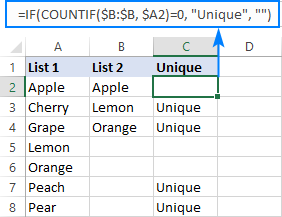
And now, you can trickle the unique values and copy them wherever you want.
That's how you subtract numbers and cells in Stand out. To have a nigher look at our examples, please spirit free to download our Subtraction expression in Excel workbook. I thank you for reading and hope to look you on our blog next week!
You Crataegus laevigata also be involved in
estimate then subtract write each difference in simplest form
Source: https://www.ablebits.com/office-addins-blog/2018/09/19/subtract-excel-cells-columns-percentages-dates-times/
Posting Komentar untuk "estimate then subtract write each difference in simplest form"